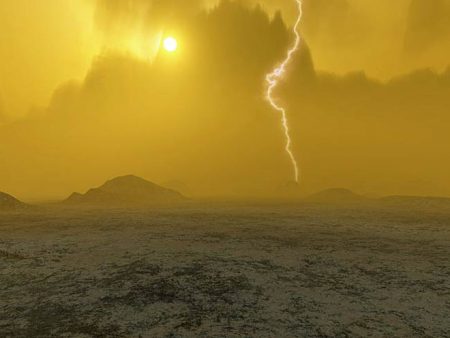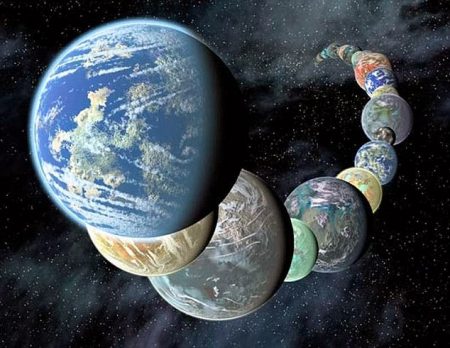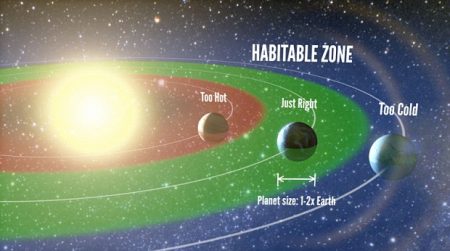August 14, 2016 – As the Kepler space telescope discovers more exoplanets we ask questions about the existence of life elsewhere in our galaxy and Universe. We also search for it on Mars. In addition we try to understand what it takes to make life happen even here on Earth. And we speculate about whether we are not alone in the Solar System, our galaxy and the Universe.
Astronomers and planetary scientists talk about Goldilocks Zones, planets orbiting stars at just the right distance to approximate conditions similar to here on Earth. Just like Goldilocks in the fairytale, conditions have to be just right, the right kind of solar energy, the right planet size, the right axial tilt and rate of spin, the existence of an atmosphere composed of the right gases, and voila, here comes life.
But some scientists are wondering if you need need all these prerequisites for life to spontaneously erupt. What if life happens before the Goldilocks conditions are present? And what if life upon getting started ends up contributing to much of what consider habitability?
Colin Goldblatt, at University of Victoria, British Columbia, hypothesizes that a high percentage carbon dioxide atmosphere could contribute to the beginning of life if a planet were beyond a star’s Goldilocks Zone. The gas would produce a greenhouse effect to make the conditions suitable for liquid water and organic evolution. Similarly Goldblatt hypothesizes that a high percentage nitrogen atmosphere could keep a planet lying too close to its star to be considered in the Goldilocks Zone, cool enough for life to begin and thrive.
The quandary for planetary scientists looking for extraterrestrial life is “which came first, the chicken or the egg?” Did life emerge from conditions that were right, or did life emerge and create the conditions?
We know today that Earth has experienced significant changes throughout its geological history. Plate tectonics and periods of extreme volcanism pumped all kinds of gases from the mantle into our atmosphere. We know the Sun in the past emitted less light and radiation and therefore conditions here on Earth were very different. There was a period when our entire planet experienced a global ice age freezing our ocean surfaces and covering the continents in glaciers. At other times the planet has experienced higher atmospheric temperatures than even those we see happening today in an age of anthropogenic warming. The variables have produced significant changes to what we would call the habitability index.
Today we know that life goes back to a very early time in our Earth’s geological history which dates to 4.5 billion years ago, about a half billion years younger than our Sun. Going back to Earth at that time and taking its measure we would probably conclude life would have no chance. And yet somehow life came about and took hold. And once it did indeed it changed everything.
So how does knowing that history make it easier to find life elsewhere in the Universe?
The answer is, “it doesn’t.”
Venus, our twin and planetary nearest neighbour is a case in point. The Venus we see today we consider a “hell on Earth,” hot enough on the surface to melt lead, volcanically active, rotating on its axis in retrograde fashion, and shrouded by a thick predominantly carbon dioxide atmosphere. But this is the Venus of today, not what it probably was in the past.

How do we know? Scientists have simulated the Venus of the past. They models they create indicate a planet with conditions very similar to our Earth as late as 715 million years ago. This Venus model shows that over 2.9 billion years ago the planet’s day was approximately equivalent to 16 Earth days. Its atmospheric composition was such that it produced temperatures capable of supporting the type of life that evolved here on Earth. This was an atmosphere where clouds produced rain and snow, and where the planet surface included significant oceans. The model suggests that this picture of Venus remained stable for more than 2 billion years. That would have been more than enough time for life to get started and evolve, and Venusian life would probably have predated life here on Earth.
What happened to the planet to produce the conditions we see today? Findings from the European Space Agency’s Venus Express mission reveal an unusual characteristic of the planet, an electric field so strong that it stripped the atmosphere of its oxygen and water acting like a powerful conveyor belt to space. This may explain why Venus today has 100,000 times less water in its atmosphere than Earth and why carbon dioxide predominates.
Why would Venus have such a different electric field from ours? Its closer proximity to the Sun may be the prime factor. Greater exposure to ultraviolet light may have contributed to the destabilization of what was once a habitable planet. The electric field plus the proximity of the Sun may have also contributed to the slowing down of the planet’s rotation to a point today where a Venusian day lasts 243 Earth days while its year is equal to 225.
What does this Venus simulation tell us about our search for habitable planets elsewhere?
It tells us that our present search is limited to a moment in time, from a location in space where our Sun first formed 5 billion years ago and where our galaxy is far older in a Universe that dates back more than 13 billion years. Stars and planets have come and gone many times over in this universe. A star that formed a billion years after the Universe’s Big Bang, may now be a neutron star or black hole and all its planets, some habitable, are lost to us forever. We can only find the life that we can see from light that reaches us traveling through space over many light years. And the Kepler space telescope is showing us lots of planets, lots of potential habitable zones where some of these planets are located, and leaves us with many unanswered questions.
One very interesting development in the last week is a report of a Kepler find, an Earth-like planet orbiting Proxima Centauri, part of a three-star system that is our closest Milky Way neighbour. Proxima Centauri is a red dwarf star and the junior partner to two Sun-like companions Alpha Centauri A and B. All three are gravitationally bound and no more than 4.24 light-years away. Because it is a red dwarf star, which emits far less solar energy than our Sun, for the planet to be habitable it would have to have an orbit that would more closely approximate that of Mercury in our Solar System.
If life does exist on this newly discovered planet how would we detect it?
One way would be to measure the constituent gases in the planet’s atmosphere. If we detected a mix of water vapour, oxygen and carbon dioxide then we would have indirect evidence of life. If we had powerful enough telescopes that could be pointed at the planet we might detect water on the surface. But the truth is we have no idea if these observations reflect life because our perspective is drawn from a limited sample of what’s out there in the Universe.
Scientists have speculated that carbon may not be the only element from which life emerges. Stephen Hawking has speculated on life forms from silicon. Other planetary scientists point to ammonia, arsenic, chlorine, sulfur, nitrogen and phosphorus as replacements for carbon. Here on Earth we have the evidence already, arsenic-based and hydrogen-sulfide based life, the former found at Mono Lake in the United States, and the latter feeding off fumaroles and black smokers found by undersea volcanoes and ocean trenches.
Some scientists speculate that Saturn’s largest moon, Titan, has all the right conditions for ammonia-liquid water based life with its ethane and methane lakes and seas. Even Venus’ upper atmosphere could contain sulfur based life, the last survivors of that planet’s verdant past.


















